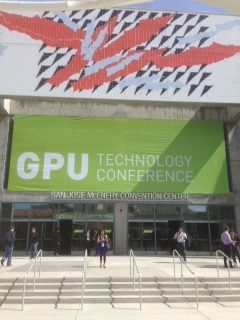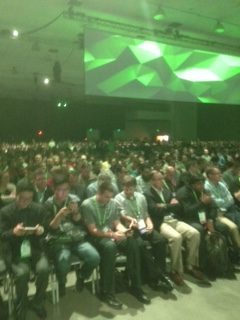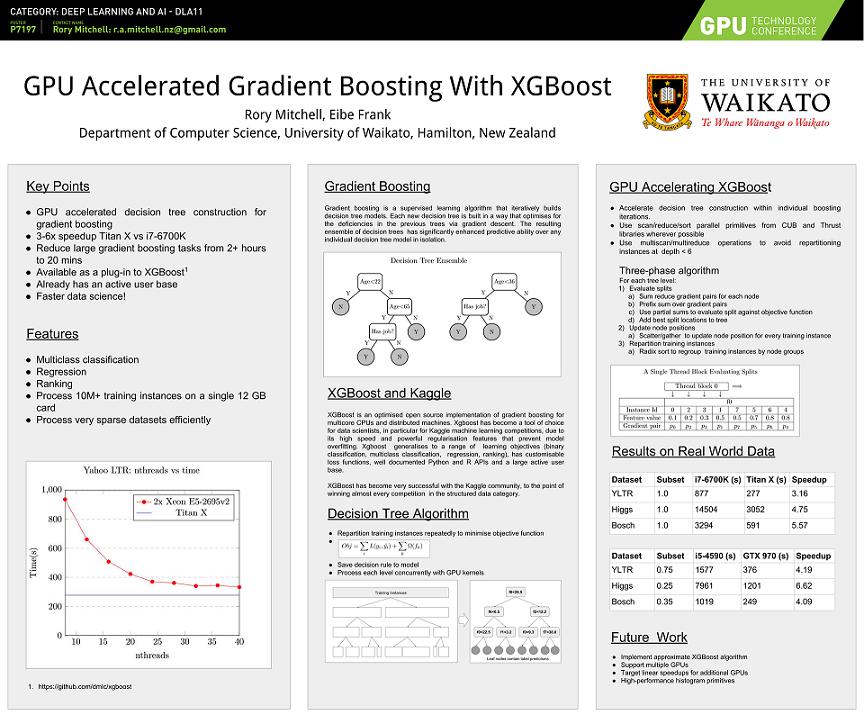 FIELD REPORT
FIELD REPORT
I was very pleased to attend the GPU Technology Conference 2017 as the guest of host company NVIDIA on May 8-11 in Silicon Valley. This was my second GTC as I became acquainted with the GPU (graphics processing unit) universe last year while attending the conference. You can read my 2016 field report HERE. I was so impressed with NVIDIA last year, I assumed it was just an outlier and that this year the company would come back down to earth. I was wrong. I was equally impressed with what I saw at this year’s installment terms of how GPUs and NVIDIA are transforming the field of AI and deep learning. This Field Report chronicles what I saw and I’m delighted to share my experience with all of you!
I’ve been following NVIDIA closely since last year, and the company continues to provide the technology required to make AI training and inference a reality. AI, machine learning and deep learning are primary topics for insideBIGDATA’s coverage areas. As was the case last year, the overarching theme of GTC was “AI” and “deep learning” along with all the exciting use cases enabled by the technology.

7000+ attendees in store for the key note address
Key Note Madness
I was looking forward to the big Wednesday morning keynote address by NVIDIA CEO Jensen Huang. I learned last year what a superb tech industry showman Huang is, so I was eager to catch the show this year. The presentation included Jensen’s intractable energy, plenty of great guests, demos, use cases, and most importantly the announcements, oh the announcements! I can’t understand how one company is able to achieve so much progress in just one year. But there I was again, being bowled over with the fast paced technology roll outs. Here is a summary of my favorite announcements from NVIDIA:
NVIDIA Volta Architecture – Volta is the world’s most powerful GPU computing architecture, created to drive the next wave of advancement in AI and high performance computing. The first Volta-based processor is the Tesla V100 data center GPU, which brings extraordinary speed and scalability for AI inferencing and training, as well as for accelerating HPC and graphics workloads.
New Volta-Based DGX Systems — The company announced a new lineup of NVIDIA DGX AI supercomputers with unmatched computing performance. Using NVIDIA Tesla V100 data center GPUs based on the new Volta architecture and a fully optimized AI software package, the systems deliver groundbreaking AI computing power three times faster than the prior DGX generation, providing the performance of up to 800 CPUs in a single system.
NVIDIA GPU Cloud Platform – NVIDIA GPU Cloud (NGC) is a cloud-based platform that will give developers convenient access — via their PC, DGX system or the cloud — to a comprehensive software suite for harnessing the transformative powers of AI. NGC will make it easier for developers to access the latest, optimized deep learning frameworks and the newest GPU computing resources.
NVIDIA Deep Learning Institute – offers hands-on training for developers, data scientists, and researchers looking to solve challenging problems with deep learning.
Collaboration with Toyota – NVIDIA announced it is collaborating with Toyota to deliver artificial intelligence hardware and software technologies that will enhance the capabilities of autonomous driving systems planned for market introduction within the next few years.
SAP Brand Impact – SAP Brand Impact, powered by NVIDIA deep learning, accurately measures brand attributes such as logos in near real time. This is made possible using deep neural networks trained on NVIDIA DGX-1 and TensorRT to provide video inference analysis.

GTC party – forest of dessert trees
Fun Stuff
Attending tech conferences on behalf of insideBIGDATA is typically a lot of work, meeting with all sorts of people to get a pulse on the industry. But event organizers make sure attendees have a nice relaxing experience too. Case in point, throughout GTC had “bottomless” coffee kiosks every 50 feet or so, and the press room wasn’t the usual “cave” in some backroom; we had ample area and desks set up adjacent to the show floor. From here I was able to observe all the happenings while working on stories. Nice touch! At one point I saw a lone CEO Jensen walking quickly past saying “Hello” to passersby. And most conferences these days include a conference-wide party that everyone is invited to. GTC’s big bash was held on Wednesday night at the nearby Tech Museum of Innovation. One favorite attraction at the party, aside from wall-to-wall bars, was the forest of dessert trees!
Academia Highlights
Being an academic at heart, one of the unique aspects about GTC that I appreciated most is the research poster competition. Research posters from academia and industry must demonstrate work using GPUs. Submissions must provide actual or expected results/accomplishments and must demonstrate a significant innovation or improvement using GPU computing. This reminds of the graduate posters I used to encounter at academic conferences and seeing them gave me the warm and fuzzies. The main conference floor was lined with rows and rows of the posters. During lulls in my schedule, I found myself standing and staring at the posters for a long while. My favorite poster was “GPU Accelerated Gradient Boosting With XGBoost” because this is my favorite machine learning algorithm. So to see how it can be accelerated with GPU technology, gave me pause, and I stared at it for a long time. You can check out a gallery of all the posters on display HERE.

Exhibition Hall
A wonderful aspect of GTC is the exhibition hall. For a tech journalist like me, it is a very convenient way to get updates from many of the important members of the AI vendor ecosystem. I found a number of my favorite companies along with some new entries. I learned a lot and came away with a good feeling for the health of our industry. Silicon Valley is a perfect place for this conference, as many of the companies are local. Here is a short list of some cool vendors with some pretty hot technology:
- MapD – a fast data exploration platform. It combines an accelerated GPU-powered SQL database with an immersive visual analytics application to allow exploration of multi-billion row data sets with latencies measured in milliseconds.
- Kinetica – a GPU-accelerated, in-memory analytics database that delivers real-time response to queries on large, complex and streaming data sets: 100x faster performance at 1/10 of the hardware of traditional databases.
- BlazingDB – is a high performance GPU database that makes big data SQL lightning fast on GPUs. Their high performance data warehouse is reported to be faster than Redshift.
- H20.ai – is focused on bringing AI to businesses through software. Its flagship product is H2O, a leading open source platform that makes it easy for financial services, insurance and healthcare companies to deploy machine learning and predictive analytics to solve complex problems. The new H2O GPU Edition speeds up AI model building up to 35x faster compared to conventional CPU-based solutions.
- Bonsai – has its Bonsai Platform that completely abstracts the complexity of machine learning libraries and algorithms enabling enterprises to program AI models that increase the automation and efficiency of sophisticated industry systems.
- Neurala – a software and services company that helps bring artificial intelligence to drones, robots, cars, and consumer electronics. The company developed The Neural Brain – deep learning, neural network, AI software that makes smart products more autonomous, engaging, useful and safer to operate.
- ArrayFire – specializes in developing accelerated, scalable computing solutions on modern computational platforms for its clients. GPU and accelerator coding services.
- ScaleMatrix – offers the latest and most powerful GPU servers for deep learning applications as a service with peak performance and cost-effective pricing.
- GPU OEMs galore – including Supermicro, Inspur, ASUS and many more.
 Contributed by: Daniel D. Gutierrez, Managing Editor of insideBIGDATA. He is also a practicing data scientist through his consultancy AMULET Analytics.
Contributed by: Daniel D. Gutierrez, Managing Editor of insideBIGDATA. He is also a practicing data scientist through his consultancy AMULET Analytics.
Sign up for the free insideBIGDATA newsletter.





Speak Your Mind